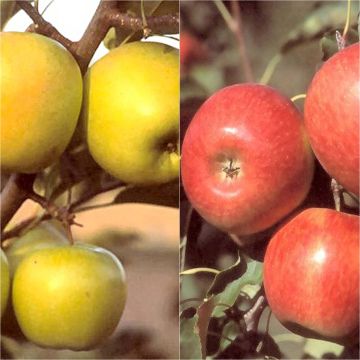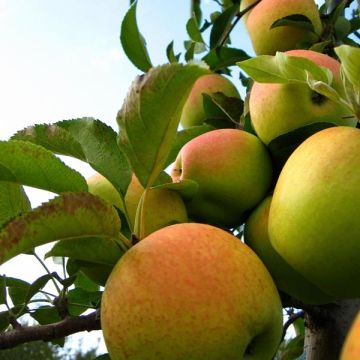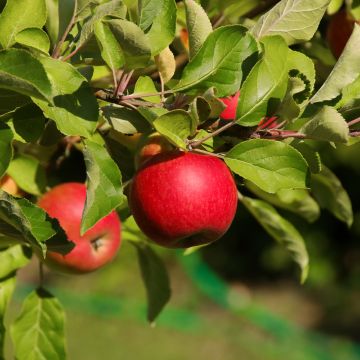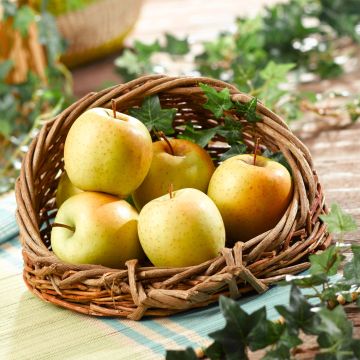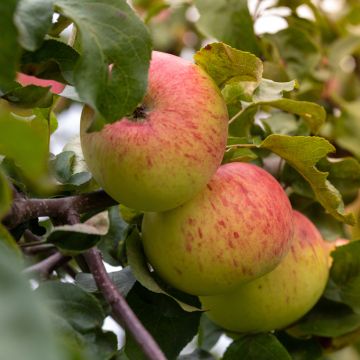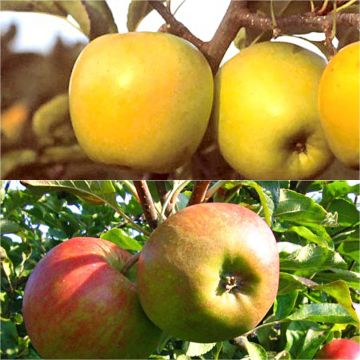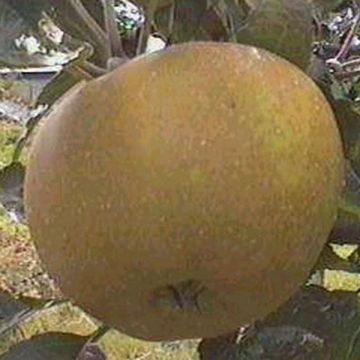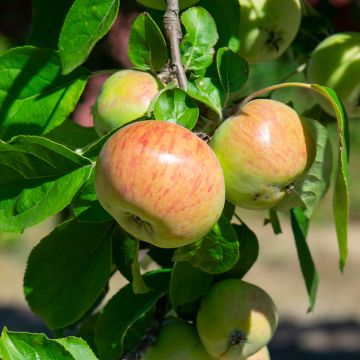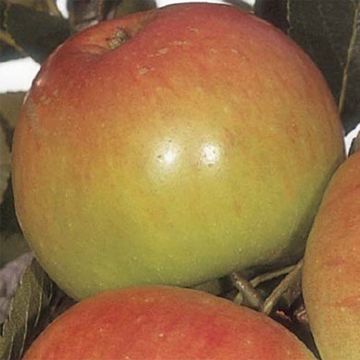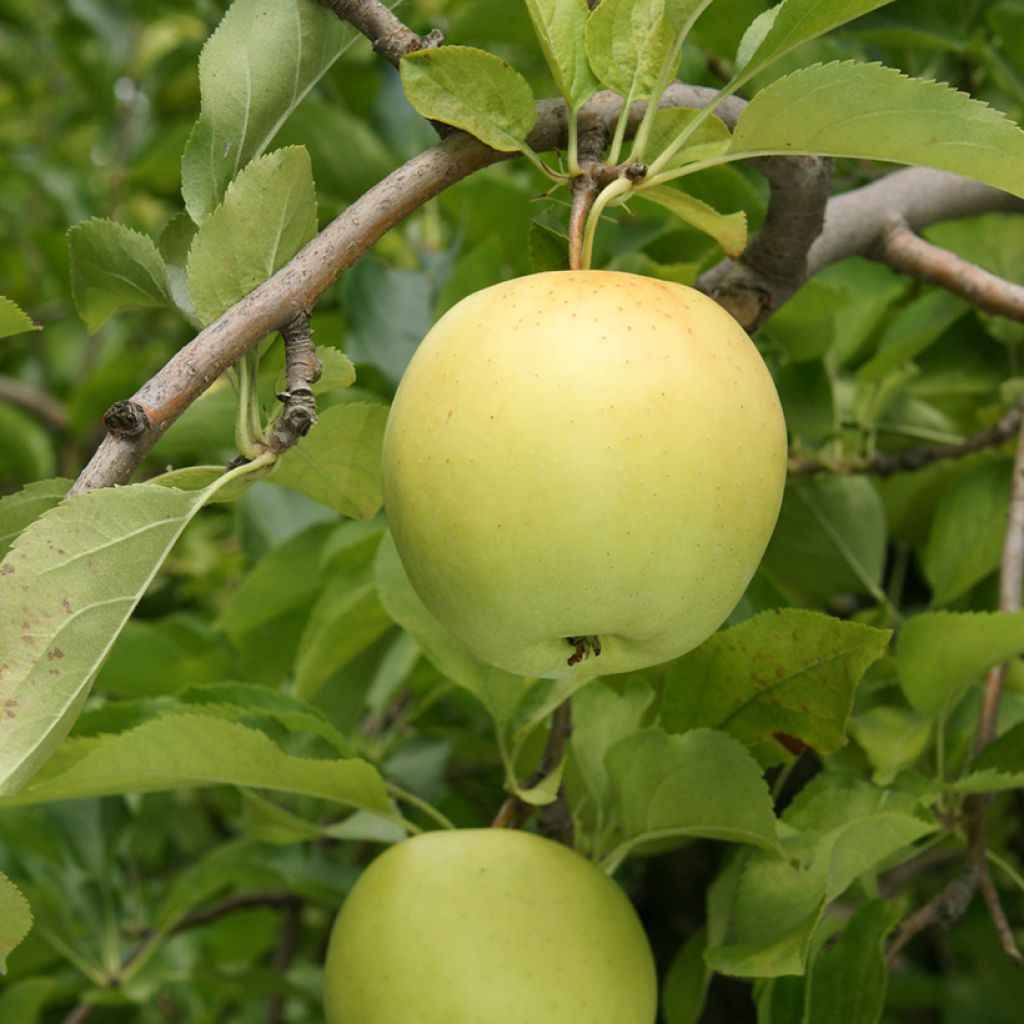

Apple Tree Antonówka Zwykła - Malus domestica
Apple Tree Antonówka Zwykła - Malus domestica
Malus domestica Antonówka Zwykła
Apple, Orchard Apple
This item cannot be shipped to the selected country
Oversize package delivery charge from €6.90
More information
Schedule delivery date,
and select date in basket
This plant carries a 6 months recovery warranty
More information
We guarantee the quality of our plants for a full growing cycle, and will replace at our expense any plant that fails to recover under normal climatic and planting conditions.
Oversize package: home delivery by special carrier from €6.90 per order..
Express home delivery from €8.90.
Description
The 'Antonówka Zwykła' apple tree is a very old Russian variety, hardy and easy to grow. It is particularly resistant to scab and powdery mildew, producing medium-sized fruits, initially greenish then turning yellow as they ripen. The flesh is juicy and crisp, very aromatic, but also very acidic, which explains why it is used more in cooking than as a dessert apple. Growing at a slow to moderate pace, the tree requires the presence of another pollinating tree to bear fruit. This variety is quite strongly biennially bearing, meaning that the harvest fluctuates from one year to the next.
The Apple Tree is a member of the large Rosaceae family, which includes most fruit genera (trees and small fruits, like Raspberry Plants...), numerous wild species from the forests and countryside, as well as a variety of ornamental plants, herbaceous, woody, and of course Roses. The Malus genus itself comprises around forty species, including the Common Apple Tree, or Malus domestica (also known as Malus communis or Malus pumila). Cultivated since antiquity (the Romans knew 29 different varieties), this tree now exists in approximately 20,000 varieties!
The Apple Tree 'Antonówka Zwykła' originates from the cold regions of Russia where its origins have been lost over the centuries. It will therefore mainly appeal to enthusiasts of ancient varieties, presenting a number of advantages, but also disadvantages that modern selections, which have undergone genetic improvements, no longer have. Growing at a slow to moderate pace, it forms a small tree of approximately 4 m in height, with a loose, spreading, slightly flattened crown. The trunk can sometimes grow slightly twisted, which, combined with the spherical crown, gives a rustic and original silhouette to the plant. This Apple Tree starts bearing fruit late, usually between 5 to 7 years after planting, so patience is required. The branches are adorned with large ovate leaves, dark green with finely toothed edges. Flowering occurs quite late around late April or in May depending on the climate, producing the typical, charming, small pinkish-white flowers of the species. They are therefore less exposed to the risk of frost, which is advantageous in areas with frequent spring frosts. As the variety is self-sterile, another tree should be planted nearby for pollination to ensure a harvest. Fortunately, many varieties can serve this purpose, such as Akane, Alkmene, Kalwila Biała, Cortland, Charłamówka, Elstar, Empire, Fiesta, Fuji, Glogierówka, Gloster, Grafsztynek Czerwony, Granny Smith, Papierówka, James Grieve, Jonathan, Lobo, McIntosh, Red Delicious, Wealthy... so you will have plenty of choices to pick a companion for it! The fruits are generally medium-sized, even small, and abundant in some years, significantly less numerous in others. This variety is quite strongly biennially bearing, meaning that a year of high production is followed by a much quieter year as the plant needs to recover from the effort exerted.
The fruits show some variability in their morphology, some are perfectly spherical, others slightly elongated, and some rather flattened. Light green at first, they turn yellow as they ripen, sometimes even covered with a light pinkish-orange veil. The smooth and shiny skin protects a crunchy and juicy, aromatic flesh (some find it has a distinct candy-like smell) that is quite acidic. For this reason, the fruit is rarely eaten fresh but rather used in pies, as accompaniments to dishes, or processed into preserves or juice. Unable to be stored for long periods, it should be used promptly after the harvest, which begins in early September and extends into October.
Very hardy and easy to grow, with low susceptibility to diseases except for fire blight, 'Antonówka Zwykła' certainly does not possess the qualities of modern hybrids and is therefore not the first choice for planting in a garden, but it will suit enthusiasts with an orchard focused on old cultivars. The Plum Tree 'Bleue de Belgique' can accompany it, with its juicy and very fruity flesh, a delight in Belgium since the mid-19th century. The Pear Tree is an essential member of any respectable orchard, and don't forget the soft fruits, Blackcurrants, Raspberries, and Redcurrant Bushes that allow for a variety of tastes...
Report an error about the product description
Plant habit
Fruit
Flowering
Foliage
Botanical data
Malus
domestica
Antonówka Zwykła
Rosaceae
Apple, Orchard Apple
Cultivar or hybrid
Other Apple trees
Planting and care
Choose a sunny spot for your 'Antonówka Zwykła' Apple Tree, the soil can be slightly chalky or acidic, but not excessively. Dig a wide planting hole at least three times the volume of the root ball. Simultaneously add organic matter (topsoil, compost...) and a base fertiliser like crushed horn. Do not bury the graft collar. Stake if necessary. For apple trees planted in isolation and in the open, it may be a good idea to stake them by installing a guy-wire system: plant 3 stakes in a triangle 50 cm around the trunk and connect them with pieces of wood. Protect the bark with a piece of rubber, for example, and attach the stakes to the trunk with metal wires. Water abundantly, even in winter and even if it rains. Fruit trees are ideally planted between October and March, avoiding frost periods. Container-grown plants can be planted all year round except during periods of high heat or frost.
In winter, at the base of the tree and slightly incorporated into the soil surface, you can add a small shovelful of wood ash, rich in potash, which will improve fruiting. Apple trees can be subject to various diseases and pests. To limit risks, space the trees sufficiently and use multi-species hedges, birdhouses or insect hotels to attract beneficial insects. In summary: favour diversity. The main diseases of the Apple tree are scab (brown spots on the leaves), apple tree canker (wilting flowers and fruit rot on the tree) and powdery mildew (white felting on the leaves). 'Antonówka Zwykła' is not reputed to be sensitive, even resistant to scab and powdery mildew, which is a definite advantage of this variety. In any case, preventive action is preferred by spraying a horsetail decoction, as a last resort and in case of severe attacks, as a curative action, you can apply a treatment based on Bordeaux mixture. However, this variety is sensitive to fire blight, against which there is no effective treatment.
As for pests, the codling moth (or apple worm) is a small caterpillar which causes tunnels inside the fruit. To remedy this, it is preferable to act preventively by encouraging birds and bats, by setting up nesting boxes. In case of aphid infestation, spray a solution based on black soap.
During the harvest, in September, use the fruits quickly by consuming them in cooking, or by making preserves, as they cannot be stored for long.
Planting period
Intended location
Care
This item has not been reviewed yet - be the first to leave a review about it.
Haven't found what you were looking for?
Hardiness is the lowest winter temperature a plant can endure without suffering serious damage or even dying. However, hardiness is affected by location (a sheltered area, such as a patio), protection (winter cover) and soil type (hardiness is improved by well-drained soil).

Photo Sharing Terms & Conditions
In order to encourage gardeners to interact and share their experiences, Promesse de fleurs offers various media enabling content to be uploaded onto its Site - in particular via the ‘Photo sharing’ module.
The User agrees to refrain from:
- Posting any content that is illegal, prejudicial, insulting, racist, inciteful to hatred, revisionist, contrary to public decency, that infringes on privacy or on the privacy rights of third parties, in particular the publicity rights of persons and goods, intellectual property rights, or the right to privacy.
- Submitting content on behalf of a third party;
- Impersonate the identity of a third party and/or publish any personal information about a third party;
In general, the User undertakes to refrain from any unethical behaviour.
All Content (in particular text, comments, files, images, photos, videos, creative works, etc.), which may be subject to property or intellectual property rights, image or other private rights, shall remain the property of the User, subject to the limited rights granted by the terms of the licence granted by Promesse de fleurs as stated below. Users are at liberty to publish or not to publish such Content on the Site, notably via the ‘Photo Sharing’ facility, and accept that this Content shall be made public and freely accessible, notably on the Internet.
Users further acknowledge, undertake to have ,and guarantee that they hold all necessary rights and permissions to publish such material on the Site, in particular with regard to the legislation in force pertaining to any privacy, property, intellectual property, image, or contractual rights, or rights of any other nature. By publishing such Content on the Site, Users acknowledge accepting full liability as publishers of the Content within the meaning of the law, and grant Promesse de fleurs, free of charge, an inclusive, worldwide licence for the said Content for the entire duration of its publication, including all reproduction, representation, up/downloading, displaying, performing, transmission, and storage rights.
Users also grant permission for their name to be linked to the Content and accept that this link may not always be made available.
By engaging in posting material, Users consent to their Content becoming automatically accessible on the Internet, in particular on other sites and/or blogs and/or web pages of the Promesse de fleurs site, including in particular social pages and the Promesse de fleurs catalogue.
Users may secure the removal of entrusted content free of charge by issuing a simple request via our contact form.
The flowering period indicated on our website applies to countries and regions located in USDA zone 8 (France, the United Kingdom, Ireland, the Netherlands, etc.)
It will vary according to where you live:
- In zones 9 to 10 (Italy, Spain, Greece, etc.), flowering will occur about 2 to 4 weeks earlier.
- In zones 6 to 7 (Germany, Poland, Slovenia, and lower mountainous regions), flowering will be delayed by 2 to 3 weeks.
- In zone 5 (Central Europe, Scandinavia), blooming will be delayed by 3 to 5 weeks.
In temperate climates, pruning of spring-flowering shrubs (forsythia, spireas, etc.) should be done just after flowering.
Pruning of summer-flowering shrubs (Indian Lilac, Perovskia, etc.) can be done in winter or spring.
In cold regions as well as with frost-sensitive plants, avoid pruning too early when severe frosts may still occur.
The planting period indicated on our website applies to countries and regions located in USDA zone 8 (France, United Kingdom, Ireland, Netherlands).
It will vary according to where you live:
- In Mediterranean zones (Marseille, Madrid, Milan, etc.), autumn and winter are the best planting periods.
- In continental zones (Strasbourg, Munich, Vienna, etc.), delay planting by 2 to 3 weeks in spring and bring it forward by 2 to 4 weeks in autumn.
- In mountainous regions (the Alps, Pyrenees, Carpathians, etc.), it is best to plant in late spring (May-June) or late summer (August-September).
The harvesting period indicated on our website applies to countries and regions in USDA zone 8 (France, England, Ireland, the Netherlands).
In colder areas (Scandinavia, Poland, Austria...) fruit and vegetable harvests are likely to be delayed by 3-4 weeks.
In warmer areas (Italy, Spain, Greece, etc.), harvesting will probably take place earlier, depending on weather conditions.
The sowing periods indicated on our website apply to countries and regions within USDA Zone 8 (France, UK, Ireland, Netherlands).
In colder areas (Scandinavia, Poland, Austria...), delay any outdoor sowing by 3-4 weeks, or sow under glass.
In warmer climes (Italy, Spain, Greece, etc.), bring outdoor sowing forward by a few weeks.

































